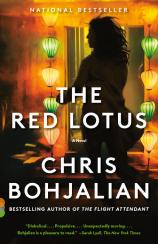The Red Lotus
Review
The Red Lotus
A thriller about an antibiotic-resistant plague-type virus carried by rats is not the obvious choice for entertainment right now, with COVID-19 dominating the news, sending us to the supermarket and drugstore to stockpile, keeping us up nights and taking lives. It feels all too real.
But before you bypass THE RED LOTUS, Chris Bohjalian’s latest, please remember that this perennially bestselling author (20 novels and counting) is not exploiting the health crisis. Obviously, he came up with the idea long before the coronavirus pandemic exploded. As he wrote recently on the Amazon Book Review Page, “The book began growing --- think a pathogen in a petri dish --- back in 2018.” He spotted a news headline about rodents as carriers of dangerous bacteria and viruses; research, and his own imagination, did the rest. And if he seems unfazed by the timing, it’s hardly surprising. This writer has always tackled controversial subjects, from contemporary ethical dilemmas (in books like MIDWIVES and THE LAW OF SIMILARS) to morally charged historical sagas (THE SANDCASTLE GIRLS, SKELETONS AT THE FEAST). Don’t expect a lecture, though; THE RED LOTUS has Bohjalian’s characteristic suspense and turn-the-page pacing.
"THE RED LOTUS has Bohjalian’s characteristic suspense and turn-the-page pacing.... It’s a cautionary bio-horror tale à la THE ANDROMEDA STRAIN and THE HOT ZONE."
Alexis, a thirtysomething ER doctor in Manhattan, has gone on a bike tour of Vietnam with her boyfriend of six months, Austin, a development guy at the same hospital. Austin has ties to the country. During the war, his father was wounded there, and his uncle died. He has ridden off on his own, ostensibly to visit the sites of those family tragedies, and now he is missing. As the story unfolds over a 10-day period, his body is found, the victim of an apparent hit-and-run, but it soon becomes clear that more is at stake here than a simple accident. Alexis discovers that he lied to her about his background, and there was another woman in his life.
Back in New York, drawing on her medical expertise, Alexis analyzes the mystery as she would a patient. She works backward, “moving intellectually from effect to cause” and eventually recognizing a pattern, making a diagnosis. What she does as an emergency physician, she realizes, is very Sherlock Holmesian: “detective work based largely on deductive reasoning.”
Parallel to Alexis’ search for the truth about her dead lover is an unnamed narrator who interrupts the story periodically for what seems at first to be unrelated historical observations: about the damage done to Vietnam by the use of napalm and herbicides during the war; about research on species that survived the depredations and became potential carriers of disease --- in effect, biological weapons. “[T]he most effective delivery vehicle for mass death ever to exist on earth has been…the rat,” says this anonymous voice (whose identity remains a secret almost to the end). If you are squeamish, be warned that you will learn more than you ever wanted to know about rats from THE RED LOTUS.
One of the reasons I am so fond of Bohjalian’s books is that they often explore deeper veins of emotion or social/historical significance. THE RED LOTUS, for example, is also a novel about loss. When Alexis was in third grade, her father died suddenly in a car accident, leaving her with an investment banker mother who “was loving without being compassionate, caring without being kind.” Alexis has a “cutting kit,” long untouched after her recovery from years of self-harm. But now, as she vacillates between “the focus of a physician and…the despair of a man or woman newly widowed,” she is on the brink of using the scalpel on herself again.
The private investigator Alexis hires to help, Ken Sarafian, is also bereaved. The case reminds him not only of his dead daughter, but of his Vietnam War experience (“the ruin they --- Americans --- had wrought upon a whole nation”) and a parallel genocide inflicted on Armenians by Turks in the late 19th century (Ken, like Bohjalian himself, is a descendant of Armenian immigrants who survived the slaughter).
The very title suggests the importance of private grief. The red lotus, Vietnam’s national flower, is supposed to heal a broken heart. It is also, more ominously, the nickname for one of the deadly rat-borne pathogens being developed in a secret lab in New York.
In THE RED LOTUS, the disease is produced by a conspiracy; the coronavirus was not. But the novel’s overlap with our alarming reality makes its impact different from Bohjalian’s quieter, more intimate works. It’s a cautionary bio-horror tale à la THE ANDROMEDA STRAIN and THE HOT ZONE.
As for the rats that are so central to the story, factually speaking, there’s nothing horrific about them. Smart, clean, affectionate, they’re potentially “delightful” pets. But still I shudder when I see one on the subway tracks or imagine them in the lower depths of my street or apartment building. This book isn’t going to do much for their reputation.
Reviewed by Katherine B. Weissman on March 20, 2020




